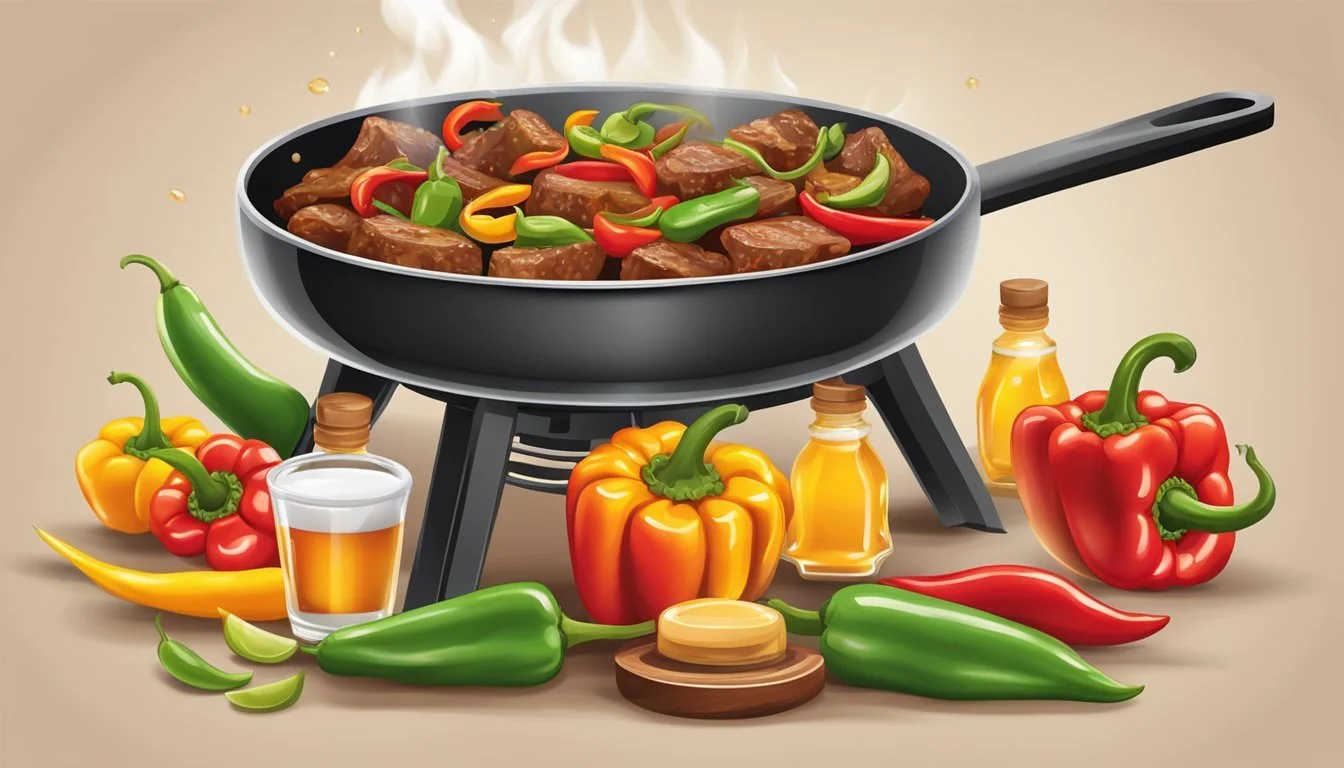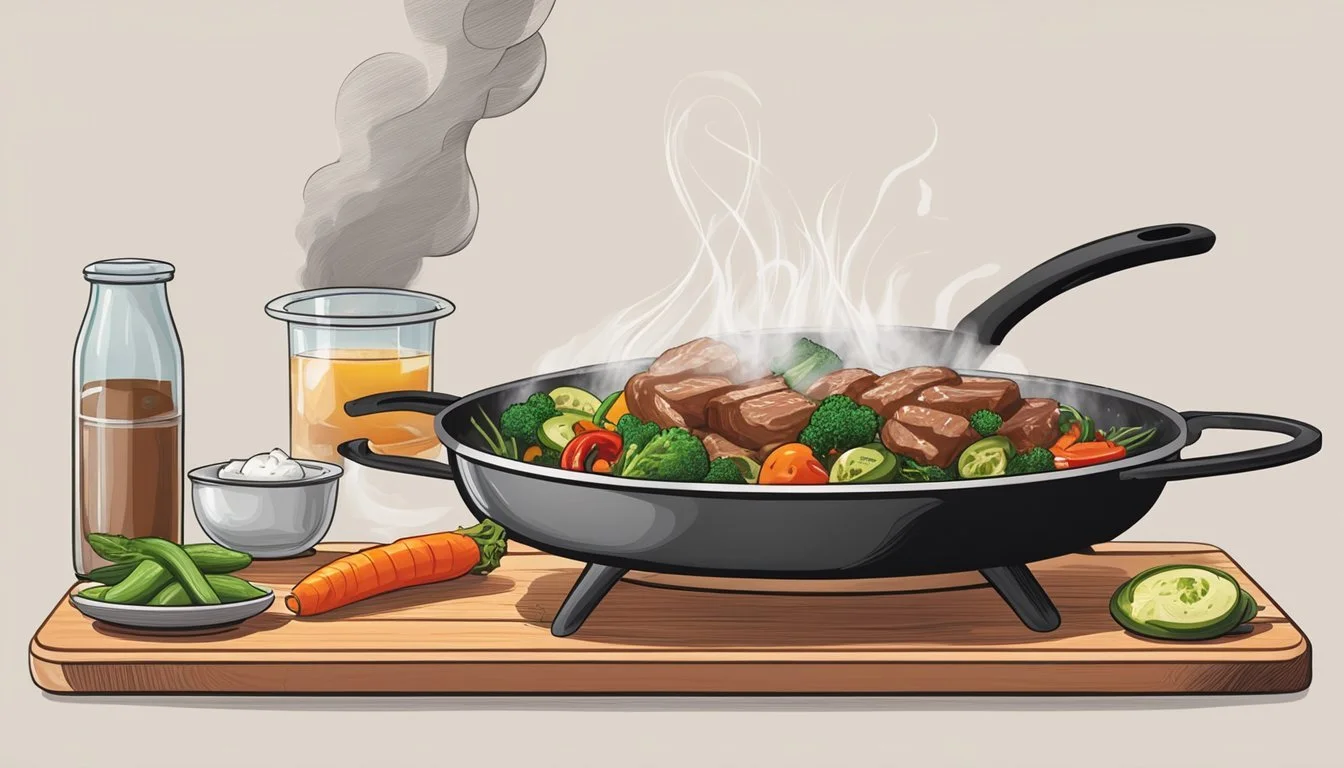Swicy Meat Marvels
Mastering the Art of Sweet and Spicy Flavors
The culinary landscape is ever-evolving, and one of the latest trends to make a significant impact is the "swicy" phenomenon—a term coined to describe the fusion of sweet and spicy flavors. This harmonious blend has particularly found its place in meat dishes, where the heat from spices meets the mellowing sweetness, creating a depth of flavor that tantalizes the palate. Swicy meat marvels are a testament to the creativity of chefs who skillfully balance these two contrasting tastes, resulting in dishes that offer a complex and satisfying eating experience.
In meat preparations, swicy notes work exceptionally well due to the inherent robustness of proteins that can stand up to strong flavors. The sweet elements often come from ingredients like honey or agave, while the spicy kick is achieved through various chilies or pepper-based sauces. These elements combine to not only enhance the distinct taste of the meat but also contribute to a multi-sensory dining experience where the mouthfeel and olfactory satisfaction are as important as the taste itself. The rise in popularity of swicy flavors is underpinned by an increase in consumer desire for bold, dynamic dishes that break the monotony of traditional meat recipes.
Embracing the swicy trend enables a dive into a world where the sweetness can offset the potentially overwhelming heat, allowing for a wider appeal among those who might shy away from overly spicy foods. (What wine goes well with spicy food?) Moreover, the sweet-spicy dichotomy has proven to enhance the meat's natural flavors, ensuring that each ingredient sings alongside the others. As this culinary trend continues to gain traction, it's clear that swicy meat dishes are not just a fleeting fancy but rather a staple in the repertoire of modern gastronomy, offering a complex, multi-layered flavor profile that speaks to the adventurous nature of contemporary cuisine.
The Science of Sweet and Spicy Flavors
In exploring the interaction between sweet and spicy flavors, one discovers a dynamic balance where sugar tempers the heat of capsaicin, creating a harmonious taste experience in meat dishes.
Understanding Sugar and Spice Interactions
Sugar and spice are fundamental elements in cooking that perform a delicate dance on the palate. Spiciness is not a taste but a sensation, triggered when capsaicin binds to pain receptors in the mouth, simulating a burning feeling. This can be intense, especially in meat dishes that incorporate robust spices.
Conversely, sugar offers a sweet counterpoint that mitigates the fierce heat. On a molecular level, sugar doesn't neutralize capsaicin but distracts the brain by sending pleasure signals that rival the spiciness. This results in flavors perceived as less aggressive and more palatable.
Balancing Capsaicin with Sweetener Options
Identifying the ideal sweetener to counteract the heat in spicy meat dishes can be akin to a culinary quest for balance. Various sweeteners can be employed, each bringing its own characteristics to the table:
Granulated sugar: A conventional choice that dissolves well, delivering a straightforward sweetness.
Honey: Adds depth with its floral notes and is excellent for glazing.
Maple syrup: Introduces a woodsy sweetness, pairing well with earthy spices.
Agave nectar: A fructose-rich alternative that provides a milder sweetness.
For a well-rounded swicy meat dish, the proportion of sugar to spice needs careful calibration; too much sweetener can overpower, while too little might not sufficiently tame the heat. Cooks often make adjustments based on the type of meat and the desired final flavor profile.
Selecting Quality Ingredients
Creating swicy meat dishes involves a delicate blend of quality ingredients that impart both sweetness and heat, ensuring an elevated gastronomic experience.
Choosing the Right Proteins
When one selects proteins for swicy dishes, consistency in quality is paramount. For beef, one should look for firm, dense cuts that are dry to the touch, ensuring the meat fibers are tightly packed. With poultry, firmness and dryness are also indicators of freshness. These protein foundations will carry the sweet and spicy flavors well.
Picking Fresh Peppers and Spices
Freshness in peppers and spices is essential to impart the desired heat without overpowering the other flavors. One may consider a range of chili peppers, from the mild poblano to the fiery habanero, depending on the heat level they seek. Spices should be aromatic and vibrant in color; cinnamon, black pepper, and cumin often pair well with sweet profiles.
Opting for Natural Sweeteners
To compliment the heat, natural sweeteners such as honey, maple syrup, or brown sugar can be used to achieve the swicy balance. Honey, especially hot honey, has gained popularity, offering a robust and earthy sweetness that contrasts the heat. Maple syrup brings a woody, caramelized flavor, while brown sugar adds a deep, molasses-like sweetness that can round out the sharper tones of citrus or pepper.
Heat Level Management
When crafting meat dishes with a 'swicy' profile—a blend of sweetness and spiciness—it's crucial to control the heat level to accommodate a range of palates and to balance flavors effectively.
Controlling Spiciness in Dishes
One can effectively manage the heat in a dish by understanding the role of cayenne pepper. Renowned for its potent spiciness, cayenne's heat comes from capsaicin, which can be moderated with certain ingredients. Dairy products, like milk or yogurt, have a chemical ability to neutralize capsaicin. Chefs may also consider adding sweet elements, such as sugar or honey, to create a counterbalance.
Key Ingredients to Control Spiciness:
Dairy: Milk, yogurt, cheese
Sweeteners: Sugar, honey
Adjusting spiciness isn’t solely about adding ingredients—removal is another strategy. If a sauce is too prominent in cayenne, chefs might remove a portion of the sauce and add a milder liquid.
Dilution Techniques for Overly Spicy Food
When a meat dish turns out too spicy, dilution offers a rescue approach. Introducing additional ingredients to the dish can help spread out the spicy molecules from the chilies. Liquid solutions, such as broths or water, are practical; however, they might water down flavors. A more flavor-intact approach involves adding starches, such as rice or potatoes, which absorb and disperse heat without significantly altering taste.
Techniques for Dilution:
Increase volume with starch: Add rice or bread.
Increase volume with liquid: Stir in more broth or tomato sauce.
Add acidic components: A splash of vinegar or lemon juice can shift the flavor profile away from pure heat.
Whether a chef opts to infuse their meat dishes with cayenne for a fiery kick or to dilute an overly hot sauce, mastery over these techniques is key to ensuring a balanced and enjoyable 'swicy' dining experience.
Creating Savory Meat Dishes
In crafting savory meat dishes, the fusion of sweetness with a hint of heat creates an irresistible combination. Chefs often aim for a balance that satisfies the palate without overwhelming it, which can be achieved through careful seasoning and the right mix of ingredients.
Recipes for Sweet and Spicy Meatballs
Ingredients:
Meats: Ground beef or a blend of beef and pork
Seasoning: Garlic powder, onion powder, chili powder
Sweet Elements: Brown sugar or honey
Spicy Components: Hot sauce
Procedure:
Mix the meats with seasoning, forming into small balls.
Combine sweet elements and spicy components for a sauce.
Bake meatballs, then coat with sauce and serve.
These meatballs serve as a perfect appetizer for game days or as a main dish.
Casseroles and Stews Infused with Flavors
Casseroles
Layer meats, tomatoes, and chili powder for a spicy base.
Top with cheese and bake until bubbling.
Stews
Brown meats and simmer with tomatoes and seasoning.
Infuse with a splash of hot sauce for tailored heat.
Casseroles and stews are ideal for communal dining and are especially comforting when the weather cools down. Whether one is preparing a casual family meal or entertaining guests, these dishes can be a hearty centerpiece.
Complementing Flavors and Textures
Creating balanced meat dishes involves harmonizing sweetness and heat while addressing the role of textures and side elements. The inclusion of compatible flavors and contrasting textures can elevate the main course, making the dining experience memorable.
Side Dishes that Enhance Main Courses
Choosing side dishes is a crucial step in completing the flavor profile of meat dishes that walk the fine line between sweet and spicy. The ideal side should either complement or contrast the main flavor elements without overpowering them.
Potatoes: A classic choice, potatoes can be prepared in various ways to suit the level of heat in the main dish. Roasted or mashed, they offer a neutral base that helps in balancing strong flavors.
Sour Cream: A dollop of sour cream can cool down the fiery aspect of a spicy meat preparation. It adds a creamy texture and a slight tang, providing a counterpoint to both sweet and heat.
When considering salt, it is essential to season side dishes carefully to avoid overpowering the meal's flavor balance. Salt can enhance the natural flavors of the sides and should be used judiciously.
Incorporating Fruits and Dairy for Balance
Fruits and dairy products have a natural capacity to soften the intensity of spiciness while working seamlessly with sweetness in meat dishes.
Pineapple: The enzymes in pineapple break down protein fibers, tenderizing the meat and adding a juicy sweetness that complements heat.
Citrus Fruits: Lime and orange provide acidity, which can cut through the richness of savory meats and bring balance to the flavor profile.
For dairy, options like milk and cheese offer both fat and creaminess, which help in moderating the spiciness of a dish.
Milk: It can be added to sauces to reduce heat and create a smoother texture.
Cheese: When melted over spicy meat dishes, cheese adds a layer of richness that pairs well with both sweet and spicy components.
By using these ingredients thoughtfully, chefs create dishes with a symphony of flavors and textures that appeal to a broad range of palates.
Fine-Tuning Your Recipes
Mastering the balance of sweetness and heat in meat dishes involves careful fine-tuning. A successful recipe not only requires the right ingredients but also hinges on meticulous taste testing and adjustments.
Taste and Adjust
One prepares their dish by tasting as they go; it’s essential to ensure the desired balance between sweetness and spiciness is achieved. For example, if one’s using hot honey as a glaze, they would taste the meat after application to decide if more sweetness is needed, perhaps by adding a touch of sugar, or more heat, potentially with a pinch of chili flakes. Seasonings are powerful, and even a small change can have a significant impact.
The Importance of Recipe Testing
When developing a recipe, it isn't enough to just mix ingredients and hope for the best; diligent recipe testing is crucial. They should prepare the dish multiple times, tweaking the seasonings and measurements with each iteration. This process isn't simply about getting the flavors right; it's also about ensuring consistency across servings. For meat dishes that embrace a 'swicy' profile, where sweet marries with spicy, precision in seasoning is especially vital.
By persistently tasting and adjusting, one hones their recipe to a point where sweet and spicy elements are in harmonious proportion, providing a reliable and delicious result every time.
Understanding Culinary Trends
Culinary trends evolve with changing tastes and cultural influences, striking a balance between tradition and innovation. The surge in popularity of 'swicy' flavors, a blend of sweet and spicy, epitomizes this dynamic shift in gastronomy.
Datassential Reports on Swicy Tastes
Datassential, a leading market research firm, has reported a significant rise in sweet and spicy pairings on menus, with a 38% increase in the last year. Gochujang, an umami-rich Korean condiment with a swicy profile, embodies the fusion of sweet, spicy, and Asian flavors that are driving this trend. The interplay of heat from chili and the inherent sweetness in the sauce captures the essence of this culinary trend. This shift signifies consumers’ growing appetite for complex and layered flavor profiles.
Incorporating Modern Sweet and Spicy Twists
Restaurants and chefs are adopting this swicy trend, crafting dishes that blend the heat of spices with contrasting sweet notes. Modern culinary approaches to meat dishes often incorporate sauces like hot honey, which add both a sticky sweetness and a zesty kick, resonating with the quest for new taste experiences. The trend is not just an addition to Western cuisines but is also influencing the innovation within traditional Asian flavors, where balance is key, and terms like swicy are becoming more mainstream.
Cooking Techniques and Tips
When crafting swicy meat dishes that balance sweetness and heat, the marination process and precise control of cooking temperatures are pivotal for enhancing taste and achieving the ideal texture.
Marinating for Maximum Flavor
Marinating meat serves the dual purpose of infusing flavors and tenderizing. For swicy (sweet and spicy) dishes, a marinade combining sugar elements, like honey or brown sugar, with heat sources such as chili peppers, garlic, and spices ensures that the flavors penetrate deep into the meat. Here's a quick guide to an effective marinade:
Sweeteners:
Brown sugar or honey: Creates a caramelized glaze when cooked.
Fruit juices: Subtle sweetness and tenderizing enzymes.
Spicy Components:
Chili powder or hot sauces: Controls the spice level.
Garlic and onions: Provide pungent depth.
Tip: For meats like beef or pork, marinating for several hours or even overnight maximizes taste and texture, whereas fish or chicken requires less time to avoid mushiness.
Proper Cooking Temperatures for Meats
Achieving the right internal temperature is essential for both safety and quality. Overcooked meat can become dry and tough, overshadowing the swicy balance, while undercooked meat poses health risks. Consulting a meat temperature chart while cooking can prevent such issues. For example:
Meat Type Temperature Range Beef or Pork (medium) 145°F (63°C) Chicken 165°F (74°C) Fish 145°F (63°C)
When preparing dishes like stew or soup, simmering at lower temperatures allows flavors from the sweet and spicy components to meld together without losing individual distinctiveness. Remember to:
Check the meat temperature towards the end of cooking time.
Rest meat after cooking to let juices redistribute, enhancing moistness and flavor.
Adjust heat levels depending on whether it’s a slow-cooked stew or a quick-seared steak to ensure the sweet-spicy profile is prominent but not overwhelming.
Building a Balanced Flavor Profile
Mastering the balance of sweetness and heat in meat dishes is essential in crafting a satiating and dynamic dining experience. The complexity of this balance hinges on understanding how each component interacts with the main ingredient within the dish.
The Role of Acid in Sweet and Spicy Dishes
Acids are pivotal in sweet and spicy dishes (What wine goes well with spicy dishes?) as they cut through richness and add a brightness that elevates the main flavors. Lemon juice or vinegar brings balance to the sweetness and can prevent a spicy dish from feeling one-dimensional. When working with a base of sweet and spicy elements, incorporating acids ensures the main ingredient, such as pork or chicken, retains its flavor presence without being overshadowed.
Citrus juices: work well with lighter meats, such as chicken or seafood.
Vinegars: complement heartier meats like beef or lamb.
Herbs and Vegetables as Flavor Enhancers
Herbs and vegetables can significantly enhance the flavor profile of sweet and spicy meat dishes while contributing to the overall harmony. The addition of sweet bell peppers can bring a natural sweetness that pairs well with the heat from jalapeños. Herbs like cilantro or basil not only add a fresh contrast to the warmth but also help in layering flavors that support the main ingredient without overpowering it.
Bell peppers: add crunch and a sweet note.
Jalapeños: provide a bold kick that needs to be balanced.
Fresh herbs: use to inject aroma and contrast into the dish.
Special Considerations for Dietary Preferences
When infusing meat dishes with a 'swicy' character, chefs must consider diners with specific dietary needs. The key is to balance the iconic sweet and spicy notes while adhering to dietary restrictions.
Vegetarian and Vegan Alternatives
Vegetarian and vegan diners seek 'swicy' experiences without meat. They often turn to plant-based proteins that mimic the texture and absorb flavors well. Such main ingredients can include:
Textured Vegetable Protein (TVP)
Incorporating non-dairy milk or dairy-free alternatives ensures vegans can enjoy the creamy sweetness and the heat, typically provided by dairy in swicy dishes.
Adjusting for Low-Sodium and Sugar-Free Diets
For those watching their sodium intake, low-sodium alternatives are critical. Chefs may consider:
Low-sodium soy sauce
Unsalted nuts or seeds as garnish
Sweetness without added sugar is achievable through natural sugars found in:
Fruits (purees or chunks)
Sugar-free syrups
By carefully selecting the sources of sweetness and heat, chefs can cater to various dietary preferences while maintaining the integrity of 'swicy' flavors.
Pairing Drinks with Spicy and Sweet Eats
When savory meets heat and sweetness, choosing the right beverage can enhance the experience, providing balance and complementing the flavors of the dish. The perfect drink can cool the palate, stand up to the boldness, or highlight the unique characteristics of swicy meat marvels.
Beverages to Complement the Heat
For Stews and Soups: A light and fizzy drink can soothe the palate. Consider serving a sparkling water with a squeeze of fresh lime or lemon to offer a refreshing counter to the richness of spicy stews.
Dairy-Based Options: Milk or lassi, a traditional Indian yogurt-based drink, are excellent for countering spiciness due to dairy's casein content binding to capsaicin, the compound responsible for chili heat.
Alcohol Pairings for Swicy Meat Dishes
For Hearty Meats: A well-chilled Peach Bellini or Strawberry Champagne fizz can be delightful with spicy poultry or pork, the fruity notes complimenting both the sweet and spicy glazes.
Game Day Favorites: Beers with lower alcohol content, like light lagers or pilsners, are ideal for spicy wings or sliders, matching the intensity without overwhelming the palate.
Post-Cooking Practices
Once the meat is cooked, certain practices can heighten the appeal of swicy dishes by maintaining juiciness and enhancing presentation.
Resting Meat for Optimal Juiciness
Meat and poultry: After cooking, it's imperative to allow the meat to rest. This period of inactivity helps redistribute the juices, ensuring each bite is infused with moisture and flavor. Beef, lamb, pork, or chicken should rest approximately five minutes for every inch of thickness.
Serving Suggestions and Presentation
Serving: To complement the swicy profile of the meat, consider pairing with sides that offer a cooling contrast, such as a creamy slaw or a cucumber salad.
Presentation: When plating, slice meats against the grain to showcase the tenderness and arrange on the plate to highlight the swicy glaze, inviting a visual enjoyment before the first bite.
Meal Planning and Event Catering
Catering for diverse tastes calls for a careful balance of flavors, especially when introducing innovative concepts such as swicy—sweet and spicy—meat dishes. Event planners must consider guest preferences and find a harmonious blend that will appeal to all.
Planning for Different Palates and Heat Tolerances
When incorporating swicy dishes like sweet and spicy meatballs into a meal plan, it’s crucial to gauge the heat tolerance of guests. Not everyone appreciates the same level of spiciness, so offering a range of swicy options can cater to varied palates. Appetizers are an excellent way to introduce guests to swicy flavors without overwhelming them. A good approach is to serve a swicy appetizer with a clear indication of its heat level, allowing guests to choose according to their preference.
Mild Swicy Options:
Honey Glazed Chicken Bites
Mango Salsa Topped Pork Skewers
Medium Swicy Options:
Sweet and Spicy Meatballs with a hint of ginger
Peach Barbecue Smothered Ribs
Hot Swicy Options:
Fiery Pineapple Chilli Wings
Spicy Chocolate Drizzled Bacon Strips
Preparing Swicy Dishes in Advance for Parties
To ensure a smooth service at events, many swicy offerings can be prepared in advance. For instance, frozen meatballs can be used as a base for swicy appetizers, saving on prep time. They can be glazed with a sweet and spicy sauce and reheated before serving to retain their flavor and moisture. It is paramount to handle such dishes carefully to ensure they maintain the perfect balance of sweetness and heat upon serving.
Preparation Tips:
Thaw frozen meatballs in the refrigerator a day before the event.
Prepare sauces separately and warm them before tossing with the meatballs to ensure even coating.
Keep meatballs warm in a chafing dish, so they remain at an optimal serving temperature.
Utilizing these strategies in meal planning and event catering can deliver a successful swicy themed dining experience.
Advanced Cooking Methods
In the realm of meat cookery, advanced techniques like sous-vide and smoking can elevate swicy dishes to new heights, ensuring that proteins are imbued with both sweetness and heat in a consistent and controlled manner.
Exploring Sous-Vide for Consistent Spicing
Sous-vide, a method where protein is vacuum-sealed and cooked in a water bath at a precise temperature, is exceptional for swicy meat dishes. Maintaining a specific temperature ensures that meat absorbs the sweet and spicy marinades evenly, resulting in a dish where the main ingredient, the protein, shines through with balanced flavor profiles. A table of ideal temperatures for different proteins:
Protein Temperature Chicken 149°F (65°C) Beef 129°F (54°C) Pork 140°F (60°C)
Experimenting with Smoking and Grilling
Smoking and grilling are techniques that impart a robust dimension to the main ingredients. When smoking meats, one can infuse sweet and spicy profiles by incorporating flavored wood chips like apple or hickory. Grilling, on the other hand, offers a direct approach where a caramelized crust can be achieved quickly, locking in the swicy glazes. Here's a concise list of tips for smoking and grilling swicy meats:
Marinate ahead of time to let the blend of sweet and spicy flavors penetrate the protein deeply.
Control Temperature: Low and slow for smoking, high and direct for grilling.
Wood Choice: Use fruit woods like cherry for added sweetness to combat the heat.
Frequent Basting: This keeps the meat moist and allows for layers of flavor to build up during the cooking process.
Conclusion
In the realm of gastronomy, Swicy Meat Marvels have emerged as a testament to culinary innovation. Chefs have expertly harnessed the dynamic duo of sweetness and heat, bringing forth dishes that satisfy a craving for complexity. It is the careful balance in these dishes that defines their success; neither the sweet nor the spicy component overwhelms, but rather they harmonize.
The technique of balancing flavors is paramount. Sweetness tempers the boldness of spiciness, allowing for a gradual build of heat that does not assault the palate. Conversely, the addition of heat elevates the sweet undertones, adding depth to the overall flavor profile. Meat, with its hearty nature, serves as an ideal canvas for this intricate dance of flavors.
Key aspects of crafting a perfect Swicy dish include:
Ingredient Selection: Choosing the right type of spice and counterbalancing sweetener.
Proportion: Calibrating the levels of sweetness to heat.
Layering Flavors: Building complexity with additional seasoning and cooking methods.
This trend has not only captivated food enthusiasts but also stands as a reflection of cultural fusion in the culinary world. It challenges traditional boundaries of taste sensations and provides a delightful sensory experience. Swicy dishes, especially in meat, will likely continue to captivate and satisfy those seeking an adventurous bite. The finesse in creating these dishes underscores a commitment to innovation and flavor harmony.
















